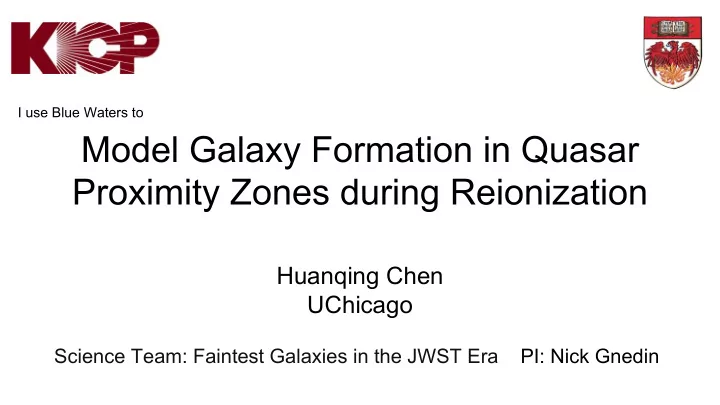

I use Blue Waters to Model Galaxy Formation in Quasar Proximity Zones during Reionization Huanqing Chen UChicago Science Team: Faintest Galaxies in the JWST Era PI: Nick Gnedin
Reionization NASA/ESA Big Problem: What Drives Reionization?
Galaxies in Reionization G. Illingworth, R. Bouwens & the HUDF09 Team
New Flagship JWST: Probing Fainter Galaxies Studying reionization is the primary science goal of JWST JWST. Hubble UD WF NASA Mason+15 Fainter
Quasars in Cosmic Reionization Quasars are ultra luminous Active Galactic Nuclei NASA, ESA, X. Fan (UA) What drives reionization? Galaxies: Quasars: Galaxy Faint Bright Many Few Quasar Mysteries of the First Quasars: Number Life time? ---> photons per quasar Host halo? ---> total number of quasars Matsuoka+18 Brighter
Current Observation Need to study quasar-galaxy coevolution! Quasar Field Random Field Underdensity? Ota+18 Ota+18
Computational Challenge Quasar Field Large Dynamical Range: Quasar proximity zone: ~ 30 Mpc To resolve galaxy: ~100 pc Use ART Code (Adaptive Refinement Tree) 1024 root grids 7 levels of refinement Ota+18
Computational Challenge Different Physical Processes: ● Dark matter ● Dark matter ● Dark matter ● Dark matter ● Gas dynamics ● Gas dynamics ● Gas dynamics ● Atomic processes ● Atomic processes ● Radiative transfer
Computational Challenge Different Physical Processes: ● Dark matter ● Gas dynamics ● Atomic processes ● Radiative transfer ● Star formation & stellar feedback >20,000 node-hours per simulation ~ 1TB per snapshot We Need Bluewaters!
3D Simulation 60 kpc No Quasar Low L Quasar High L Quasar 60 cMpc
Star Formation History without Quasar
Stars Form Earlier in Overdense Region
Quasar Radiation Suppresses Star Formation Quasar turns on
Imprints on Luminosity Function Quasar radiation does not affect the bright end Quasar radiation suppresses the faint end by ≲ 50%, Much smaller than the field-to- field variation
Summary ● Future flagship JWST will observing fainter galaxies in reionization ● Mysteries of first galaxies, first quasars and their coevolution are waiting to be solved ● 3D cosmological simulations help us understand galaxy formation in quasar proximity zones ○ Star formation history varies with distance to quasar ○ Quasar radiation suppresses star formation in low mass halos ○ Quasar radiation leaves a small imprint on the galaxy luminosity function ● Lots of fun ahead
Non-linear Luminosity Dependence (x10)
Quasar Impact Immediate Suppression in Low Stellar Mass Halos
Synthetic Observable: Luminosity Function <80% suppression on the fainter end, smaller than the field-to-field variation
Intrinsic Variation in Star Formation Histories
Immediate Suppression in Low Ms Halos
Non-linear Luminosity Dependence (x10)
Recommend
More recommend